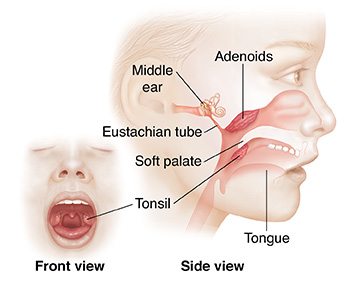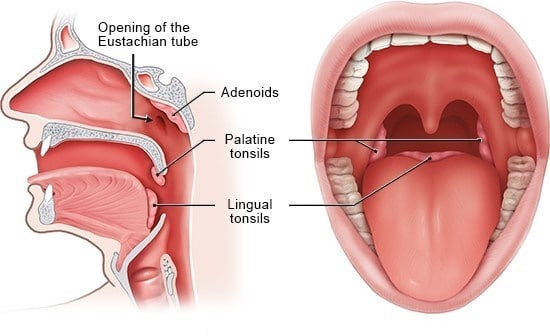TONSILLECTOMY/ADENOIDECTOMY
Everyone has small glands on each side of the throat (tonsils) and at the top of the throat behind the nose (adenoids). A tonsillectomy (ton-sil-ek-toe-mee) is surgery to remove the tonsils, while an adenoidectomy (ad-uh-noid-ek-toe-mee) is surgery to remove the adenoids. A tonsillectomy and adenoidectomy done together is also commonly referred to as a T&A.
What are tonsils and what do they do?
Technically, there are three types of tonsils: palatine tonsils, pharyngeal tonsils (adenoids), and lingual tonsils. The palatine tonsils — sometimes called faucial tonsils but often simply called tonsils — are two separate small masses of lymphoid tissue located at the root of the tongue at the back of the throat. They are the only type of tonsils that can be directly seen when we open our mouth. When we speak about tonsils we usually mean the first type, and tonsillectomy refers to the removal of the very tonsils. Tonsils are part of the body’s lymphatic system, which in turn is part of the immune system. Tonsils act as goalies for the body, meaning they prevent harmful viruses and bacteria from entering the body through the oral cavity. They also contain immune cells that produce antibodies for killing germs and preventing throat and lung infections. The adenoids have a similar function as the palatine tonsils. They are located at the end of the nasal cavity behind the soft palate. Adenoids naturally shrink as children grow up and often completely disappear by the time they reach adulthood.
How to help my child get ready for tonsillectomy?
A 3 or 4-year-old child doesn’t know anything about tonsillectomy and this is the parents’ responsibility to help them prepare for the surgery. If your child is going to have their tonsils removed, apart from the above-mentioned preparatory points, you need to take further steps as a parent to help your kid get ready for a tonsillectomy. Here are some tips for preparing your child for the surgery:
- Tell your child the reason they should have the surgery, including “you won’t get sore throat anymore.” Be specific about the benefits of the surgery.
- Talk with your child before surgery and ask them questions so that they can express their feeling. This way, you can also make sure that they are not puzzled about what is going to happen.
- Tell your child that you are going to go to the hospital in a few days. As a general rule, it is recommended that you talk about going to the hospital 2 days in advance if your child is 2 years old, 3 days for a 3-year-old child, and so on.
- Assure your child that you will be at the hospital at their side the whole time they are in the hospital.
- Explain to them that the doctor will take the tonsils out only and they won’t look any different afterward.
- If possible, find and show to your child videos of children who’ve had their tonsils removed and now talk positively about it.
How Is Tonsillectomy Done?
Tonsillectomy or adenotonsillectomy is performed under general anesthesia, meaning the patient will be put to sleep and won’t feel anything while the operation is being done. Tonsillectomy is normally an outpatient procedure and doesn’t require an overnight hospital stay for adults but children might need to spend a night in the hospital. It takes less than an hour and the patient can go home 2-4 hours after surgery if there is no need for overnight stay. Surgeons adopt different techniques for tonsils and adenoids removal. A common technique is using scalpels, which is called “cold knife (steel) dissection” method. Some surgeons prefer other methods, including cauterization (burning), ultrasonic vibration, laser, or cold temperature to remove tonsils. There is no big difference among them and the results and recovery time are almost the same. After the completion of the surgery, the patient is taken to the recovery room to be taken care of. Once the anesthetic wears off and the patient wakes up, they may feel sick and even vomit, which is a result of the anesthesia and is common.
Recovery
There are some discomfort and pain after adenotonsillectomy. The patient might have a sore throat and a pain in the jaw, neck, or ears. Getting plenty of rest during the first days after surgery is crucial for a comfortable recovery. Patients should also drink enough water to keep their body hydrated, which is essential to a good recovery. Tonsillectomy patients should avoid hot, spicy, hard, and crunchy foods (such as French fries) for a few days after surgery to prevent damage to their surgical areas. Instead, they are recommended to eat soft and plain foods such as mashed potatoes, clear broth, applesauce, ice cream, and gelatin, which are easy to swallow. However, as dairy products should be avoided during the first 24 hours after surgery, patients should go for ice creams that don’t contain milk. Patients might snore during the first 2 weeks after tonsillectomy or adenoidectomy. This is normal and should not be a cause for concern. You should contact your doctor if this lasts for more than 2 weeks or you have breathing problems after the same period of time. Also, seek medical attention if you have a high fever and bleeding (dark spots of blood in the mouth or nose are normal).It takes 10-14 days for children to recover from tonsillectomy but this may take a little more time for adults. Tonsillectomy patients can normally go back to work in two weeks.
Risks
Every surgery involves potential risks and tonsillectomy is no exception. However, thanks to the advanced surgical techniques and the high frequency of tonsil and adenoid removal surgery, tonsillectomy and adenoidectomy are usually safe. Here are the most common complications that might occur after a tonsillectomy or adenoidectomy:
- Infection: There is a slight chance of infection after tonsils removal just like any other surgery.
- Bleeding: This is a rare complication too, but smokers and alcoholics are at higher risk of bleeding after surgery. If this happens, the patients will need to stay in the hospital longer.
- Swelling: The tongue and the roof of the mouth may become swollen in the first few hours after surgery, which causes breathing problems. This is also an uncommon side effect of tonsillectomy.
- Anesthesia reactions: This is a risk in all the surgeries involve general anesthesia and is more common in people with a family history of anesthesia reactions.
















